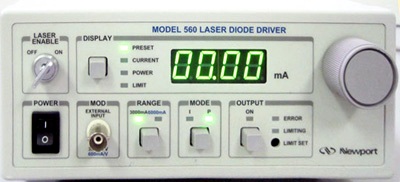
|
|
The Newport 560B is a low noise and highly stable laser diode driver for spectroscopy and fiber-optic communications applications. Two current ranges can be selected from the front panel: 0 to 3000 and 0 to 6000 mA with a current resolution of 0.06 and 0.12 respectively. Output accuracy on both settings is +/- 0.09% FS. The output compliance voltage ranges from 0 to 5.0 V. The short-term (1 hr) stability on both settings is <20 ppm FS, and long-term stability (24 hr) on both settings is <50 ppm FS. On the 0 to 3000 mA output setting, the output noise in high BW mode is less than 10.9 micro-amp rms. On the 0 to 6000 mA setting, output noise is at less than 13.8 micro-amps rms in high BW mode. Output noise in low bandwidth mode from 0 to 3000 mA is at less than 7.3 micro-amps rms, and less than 12 micro-amps rms on the 0 to 6000 mA setting. The current limit range for both output settings is 0 to full range plus 1% of full output, with a resolution of 0.06 and 0.12 mA on the 0 to 3000 and the 0 to 6000 mA setting respectively. External analog modulation allows for voltage control or modulation of the output. With an input voltage range of -10 to +10 V at 10 k-ohms, in high bandwidth mode, the modulation bandwidth on the 0 to 3000 and 0 to 6000 mA settings is DC to 300 kHz and DC to 100 kHz respectively. In low bandwidth mode, the external modulation bandwidth is DC to 10 kHz for both output settings. The photodiode input current monitor range is 0 to 50 mA, with a stability of +/- 0.02 mA per hour and an accuracy of +/- 0.05% FS. The bias voltage range is 0 to -5 V. The measurement display current range is identical to the current ranges on both output current settings. The display output current resolution is 0.1 mA on both output settings. The display can show the photodiode current in a range from 0 to 50.000 mA with a resolution of 10 mA. The user interface software and drivers are compatible with windows xp and 7, 32 and 64 bit. The Newport 560B also comes equiped with a usb 2.0 interface for remote operation.
|